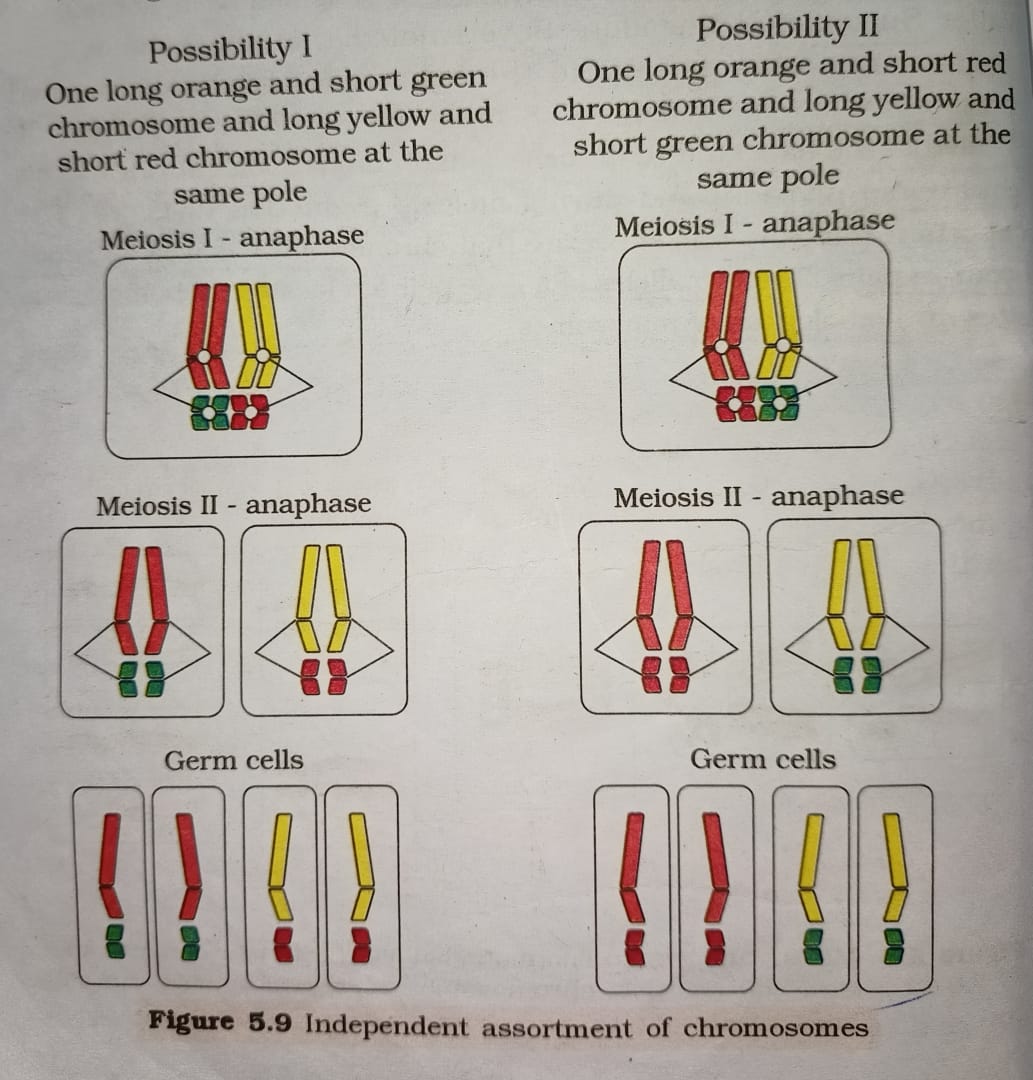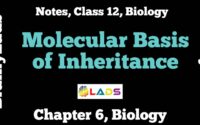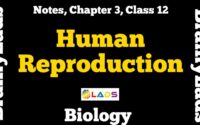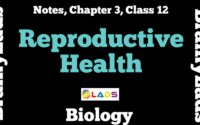Principles of Inheritance and Variation Class 12 | Chapter 5 | Biology |
Table of Contents
Principles of Inheritance and Variation Class 12 | Chapter 5 | Biology | CBSE |
- Heridity is transmission of genetic information from parents to their offsprings.
- Inheritance is the process of transmission of information from parents to their offsprings.
- Variation is the degree of difference among the progeny of the same parents or degree of difference among parents and their offspring.
Reason behind Variation –
- Paired chromosome get separate during the gamete formation.
- Crossing over during the gamete formation.
- Different combination of chromosome during gamete formation.
- Fertilization is a by – chance process.
Genetics is a branch of biology that deals with principle and processor of Heredity and Variation.
Terminology
- Offspring is progeny produced by sexual reproduction.
- Clone is a group of individual that are genetically and morphologically identical and produce to asexual reproduction.
Member of clone is known as Ramet.
- Character is a feature that defines an organism. They may be inherited or acquired.
- Trait: All inherited characters are known as Traits.
Note: All traits are characters but all characters are not traits.
- Gene/Factor is a small segment of DNA that has the information for a particular trait.
- Locus is the position of a gene on the chromosome.
- Alleles is a pair of gene that control contrasting form of a character.
Homozygous allele – If allelic form present in an individual is same. Example – T – T, t – t
Heterozygous allele – When different allelic form present in a different form. Example – T – t
Pure line/True line – Any plant which undergoes selfing for the several generation and always produce a single stable phenotype.
Phenotype – Morphological appearance of an organism.
Example – Tall, dwarf, round, wrinkled.
Genotype – Genetic make up of an organism.
Example – TT, Tt, tt.
Dominant gene – Any gene that is able to express itself in the phenotype in the presence of another allele or that express itself in phenotype in homozygous as well as Heterozygous condition.
Recessive gene – Any gene that express itself only homozygous condition not in heterozygous condition or that is not able to express itself in presence of other allele.
Wild gene – Any gene or allele i.e. present in the original population from the beginning and mainly it is dominant gene.
Mutated/Modified allele – Any allele or gene that form due to the mutation in wild gene. It is mainly recessive.
In modified allele, 3 conditions are possible –
- Lead to formation of normal enzyme or less efficient enzyme.
- Lead to formation of non – functional enzyme.
- Lead to formation of no enzyme at all.
In case 1st, both modified and unmodified allele affect remain same or both allele bring same phenotype.
In case 2nd and 3rd, modified allele not able to change the phenotype and does not express in phenotype. So, in case 2nd and 3rd modified allele become recessive allele.
Pure line/True line – Any plant or organism which undergoes selfing for the several generation and always produce same stable phenotype.
P – generation – Pair of plant that are used to initiate the hybridization process.
F1 generation – The generation that produce by crossing between two individual with contrasting genotype of P – generation and is always hybrid.
F2 generation – The generation that produce by selfing of F1 generation individual.
Monohybrid cross – A crossing between plant to study inheritance of a gene pair with contrasting trait information.
Dihybrid cross – A crossing between plant to study inheritance of two gene pair with contrasting trait information.
Test cross – Crossing between the F1 generation and recessive parent or crossing between unknown genotype plant and recessive parent plant.
Significance : It help to find out the unknown genotype of given plant.
Mendel – Father of Genetics
- Mendel was born on 22nd July in 1822 in a small village silivian in Austria.
- He joined St. Thomas Monastery of Brunn at the age of 21. In 1847, at the age of 25 he become priest of the monastery.
- He went to university of Vienna in 1851 to complete his matters in physical and botany.
- He returned in 1854 and join the Monastery as a science teacher.
- He noticed a garden pea plant in 1856 and start working on pea plant. He work for 7 years on pea plant for 1856 – 1863.
- He Publish his conclusion in 1856 and 1866 in the “4th volume of proceeding of Brunn natural history society” with the title “Hybridization in plant”.
- He get rejected and no one recognise Mendel for his work and died in 1884 without any recognisation.
- In 1900, Mendel work was rediscovered by 3 scientist independently.
Mendel selected garden pea plant for his experiment because of the following reasons:-
- Pure line easily available
- Pea plant have easily observable contrasting character.
- Pea plant have short life span i.e. of 3 months.
- In pea plant, per generation large no. of offspring produce.
- In pea plant, breeding can be controlled
- In pea plant, F1 generation is fertile.
| Character | Dominant | Recessive |
| Stem height | Tall | Dwarf |
| Flower colour | Violet | White |
| Flower position | Axial | Terminal |
| Pod colour | Green | Yellow |
| Pod shape | Full/Restricted | Constricted |
| Seed shape | Round | Wrinkled |
| Seed colour | Yellow | Green |
Mendel’s Experiment :
- Selection of Parents –
In the beginning, Mendel select 34 varieties for his experiment, than after some time, it start working only on 22 varieties, and finally select 7 variety of pea plant,
He perform self pollination within the pea plant and create pure line for his experiment.
He select 14 true/ Pure line for his experiment and every pure line has unique character.
- Controlled Hybridization –
He perform control Hybrid, between the selected parent plant.
He perform control Hybrid, by using the technique of Emasculation and bagging.
- Self Pollination of Hybrid plant –
He allow self pollination in the plant produce by crossing between parent plant.
- He collected the offspring produce by self pollination in Hybrid plant and germinate the seed and study the inheritance of character.
Monohybrid Cross
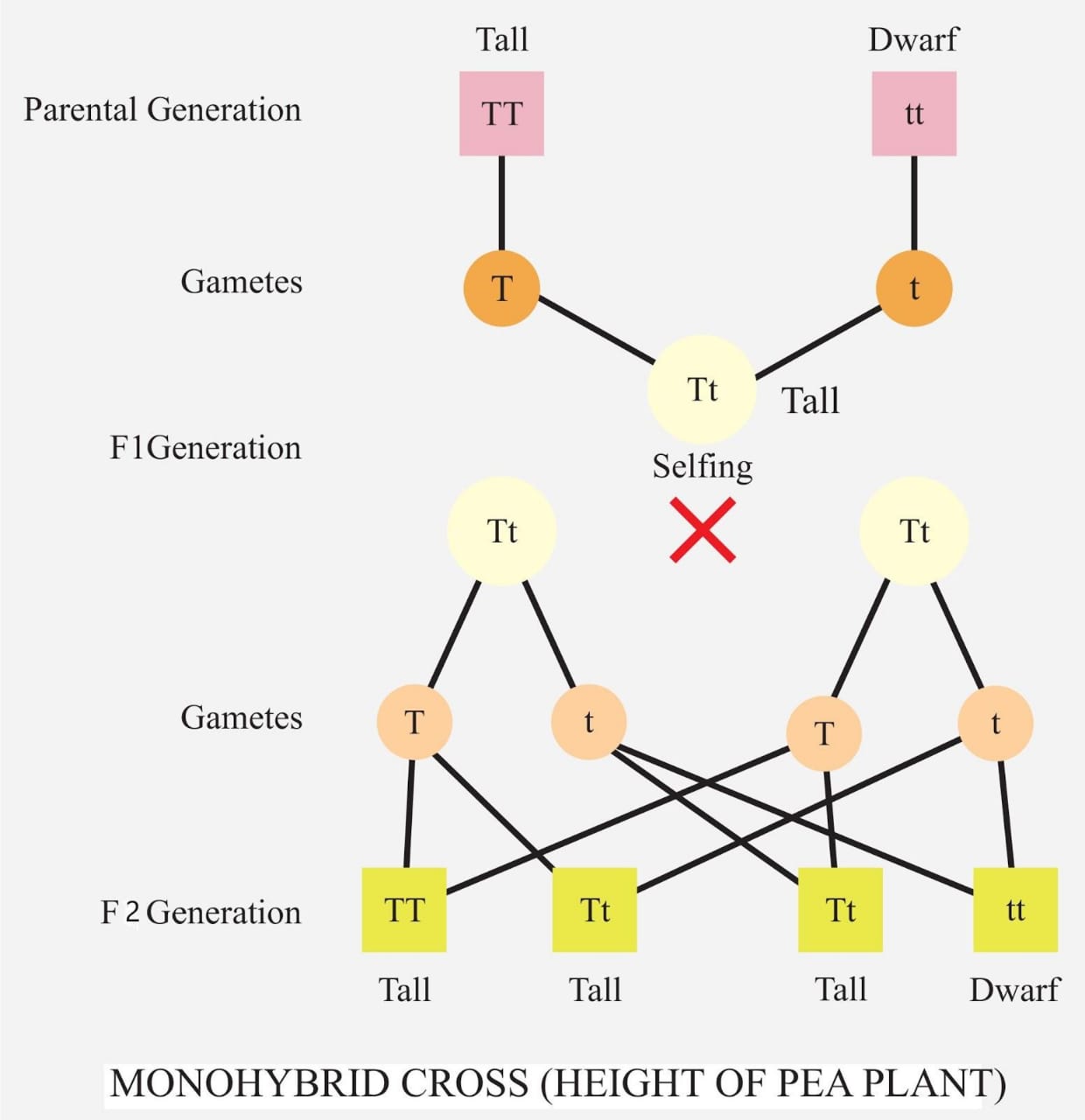
Phenotypic Ratio = 3 : 1
Genotypic Ratio = 1 : 2 : 1
Conclusion on the basis of Monohybrid cross –
- Paired factor – Every pair is controlled by 1 pair of factor.
- Dominance and Recessive – Out of the paired factor of a character, one of the factor is able to express in presence of another factor for the same character.
The factor which express itself in the Heterozygous condition is Dominant and the factor which is not able to express in Heterozygous condition is Recessive.
It is known as Law of Dominance and 1st Law of inheritance.
- Segregation – During the gamete formation paired factor get separate out and one gamete contain only 1 factor.
It is known as Law of Segregation and 2nd Law of inheritance.
Punnet Square – It is a graphical representation to calculate the probability of genotype of future generation.
Exceptional case of Mendel conclusion of Monohybrid cross-
Incomplete Dominance :
Phenotypic ratio = 1 : 2 : 1
Genotypic ratio = 1 : 2 : 1
It is a phenomena in which in Heterozygous condition, any allele is not able to express completely in the phenotype.
In heterozygous condition, an intermediate phenotype get form.
In incomplete dominance, both parents get disappear in F1 generation.
Co – Dominance
In case of co – dominance, the F1 generation resembles both parents.
Example – Different types of red blood cells that determine ABO blood grouping in human beings. ABO blood groups are controlled by the I gene.
The plasma membrane of the red blood cells has polymers of sugar that protrude from its surface and the kind of sugar is controlled by the gene.
In case of blood group A, gene A add N – acetyl galactosa mine as a terminal sugar and A gene express.
In case of blood group B, gene B add galactose as a terminal sugar and express itself.
In case of O blood group, there is no modification and gene is present in recessive form.
In case of AB blood group, both A and B gene express and add N – acetyl galactosa mine and galactose and they both express their own types of sugars ;this is because of co – dominance.
There ae three different alleles that are possible, and a total of six different genotypes of the human ABO blood types.
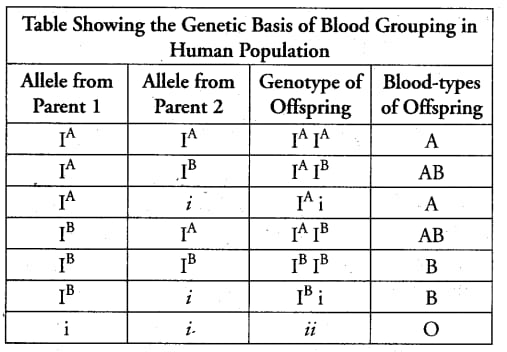
Example of co – dominance :
MN blood group in human beings
Skin colour in cattles
Complete dominance in Blood group
In complete dominance, one allele is dominant over the other allele in the pair.
P – generation AA OO
Gamete A A O O
F1 – generation AO × AO (A blood group)
Gamete A O A O
F2 – generation
| A | O | |
| A | AA | AO |
| O | AO | OO |
Phenotypic ratio = 3 : 1
Genotypic ratio = 1 : 2 : 1
Multiple Allele
It is a phenomena in which a single character is control by more than one pair of allele.
A phenomena in which more than pair of variation present at a locus in the homologous chromosome.
Inheritance of the Human blood group show co – dominance, complete dominance and multiple allele.
Concept of multiple allele applicable for the population not for the individual, as the individual is always diploid.
Pleiotropy
It is a phenomena in which a single gene control more than one phenotypic affect and the gene is known as Pleiotropic gene.
Example – (In plants) Seed shape and size inheritance in sweet pea.
BB bb
(Round, Large) (Wrinkled, small)
It produces Bb (Round, intermediate).
Dominance is not a autonomous feature of a gene, it depend upon gene product and production of a phenotype from this product.
Dominance of a gene is decide by affect of product on the production of phenotype that we examined.
Example – (In humans)
Phenylketonuria is an example of pleiotropy in which due to the mutation in the gene coding for phenyl aniline hydroxylase.
Phenyl aniline not converted into tyrosine converted to phenyl ketone and start accumulating within the body.
Accumulation of phenyl ketone cause mental retardation and depigmentation in skin and hair due to the deficiency of melanin pigment.
Inheritance of Two Gene
Mendel select the shape and color of the seed to explain the inheritance of two genes.
By using the genotypic symbols –
Y = dominant yellow seed colour
Y = recessive green seed colour
R = round shaped seeds
R = wrinkled seed shape
Genotypes of the parents = RRYY and rryy
The cross between the two plants –
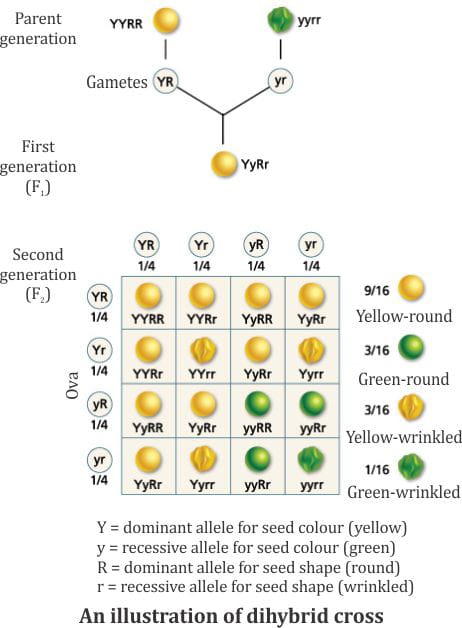
Phenotypic ratio : 9 : 3 : 3 : 1
Law of independent assortment
According to this law, in a dihybrid cross segregation of 1 pair of character is independent of another pair.
Monogenic inheritance
It is a type of inheritance in which a single gene or a allele is capable to bring up a particular phenotype.
It is a qualitative inheritance and it represent discontinuous variation.
Polygenic inheritance
It is a type of inheritance in which a single trait is controlled by more than one gene.
It is a quantitive inheritance and a single gene control only a part of phenotype and it represent continuous variation.
Reason of Failure of Mendel
- Communication was not so easy, So Mendel was not published world wide.
- Mendel explain biological phenomena by use of Mathematics. It’s a new approach i.e. not accepted by anyone.
- Mendel not able to give any proof about the location and chemical composition of factor.
- According to Mendel, factor is stable and allele never get blend. So, is not able to prove continuous variation that occur in the nature.
Due to these reasons, Mendel remain unrecognized for his work and get rediscovered after his death.
Chromosomal Theory of Inheritance
Given by Sutton and Bovary.
During the 1900, the field of microscopy was highly developed.
It was discovered that, nucleus contain one pair of structure that get double during the cell cycle.
This structure get easily stain during the staining known as chromosome.
In 1902, Sutton and Bovary notice or work out on the chromosome movement during the meiosis cell cycle and they notice behaviour of chromosome was parallel to the behaviour of gene.
They explain chromosome movement during the cell cycle to explain Mendel’s law of inheritance.
Sutton united the knowledge of chromosome segregation with Mendelian inheritance and called it Chromosomal theory of inheritance.
Parallel relationship between gene and chromosome
| Gene | Chromosome |
| Occur in pairs | Occur in pairs |
| Segregate at the time of gamete formation such that only one of each pair is transmitted to a gamete | Segregate at gamete formation and only one of each pair is transmitted to a gamete. |
| Independent pairs segregate independently of each other | One pair segregates independently of another pair. |
Independent Assortment of Chromosome
Morgan – Thomas Hunt Morgan
He is known as Father of experimental genetics and also known as fly man.
He experimentally proved chromosome theory of inheritance while working on Drosophila.
He discover linkage and give linkage theory of inheritance.
He also helps in making genetic map.
Why Morgan select Drosophila melanogaster ?
- It can easily culture on synthetic media in the lab.
- Both sex can be easily distinguish.
- A single mating produce large no. of offspring.
- It have short life span approx. 2 weeks.
- Have contrasting character that can easily observed under the light microscope.
Linkage and Recombination
Linkage
It is the tendency of a pair of gene that present on the same chromosome to stay together during the inheritance from 1 generation to the another generation without any change.
Linked gene – Gene present on same chromosome that have tendency to stay together during inheritance.
They do not follow Law of Independent Assortment.
Unlinked gene – Gene present on different chromosome and they follow law of independent assortment.
Linkage theory of inheritance
- Linkage is shown by gene present on the same chromosome.
- Linked gene are always present in linear sequence on same chromosome.
- Linkage is inversely proportional to the distance between gene.
- Linkage always maintain parental character generation after generation.
Linkage group
Group of gene that present on the same chromosome and that pass together from one generation to the another generation without any change except crossing over.
Type of Linkage
Complete Linkage –
In complete linkage, there is always form parental type of gamete and there is no tendency to separate out during crossing over.
It favours 100 percent parental combination.
Example – Male Drosophila
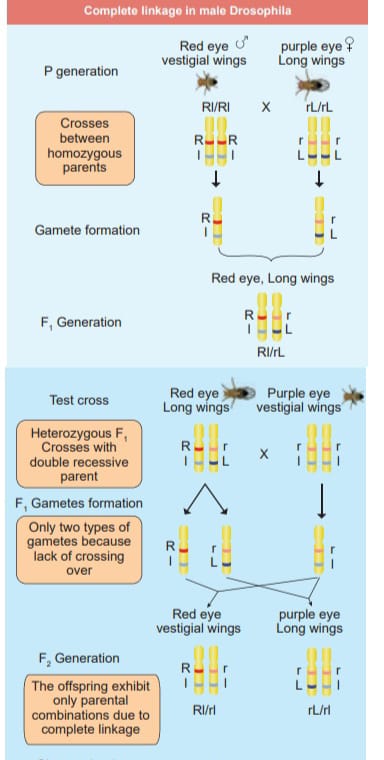
Incomplete Linkage
In incomplete linkage, maximum time linked gene stay together but in rare cases, they may get separate and form recombinant.
So, the chance of parental combination is more and chance of recombination is very less.
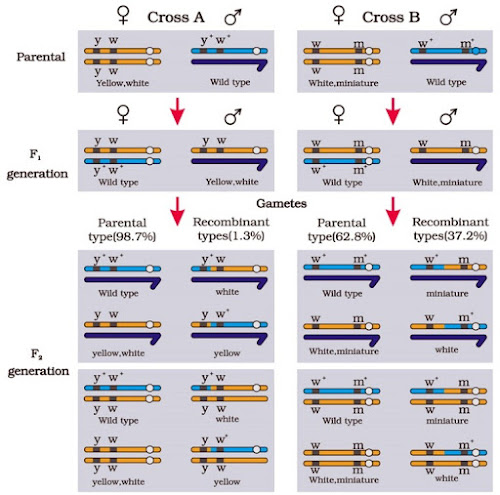
Recombination/Crossing over
It take place during the Pachytene stage of prophase I of meiosis.
During the crossing over, genetic information between the non – sister chromatid of homologous chromosome get exchange.
It brings new combination and variation in the progeny.
Crossing over between the two genes is directly depend upon distance between two gene.
Crossing over is inversely proportional to the linkage.
Recombination Frequency
It calculate the percentage of the recombinant form in total progeny.
R.F. = No. of recombinant × 100 / Total progeny
1% recombination frequency indicate 1 map unit distance between gene.
The maximum recombinant frequency between the two gene is up to 50% and if any pair gene show frequency more than 50% than it indicate gene present on the different chromosome.
Genetic map
Given by Alfred Sturtevant.
It is the presentation or finding of the location of gene present on a chromosome.
Sex Determination
Sex chromosome theory
Henking – He worked on firefly and discovered that female have an extra chromosome in comparison to Male and named it X – body.
Mcclung – He worked on grasshopper and discovered that Male grasshopper has 23 chromosome and female have 23 chromosome and called the X – body as a X – chromosome.
Steven – He discovered Y – Chromosome.
Wilson and Steven – They give sex chromosome theory of sex determination.
XX – XY type
Example – Human being, drosophila etc.
Here males are heterogametic (XY) and females are homogametic (XX).

XX – XO type
Example – Grasshopper
Here, males have only one X – chromosome while the females have two XX – chromosomes.
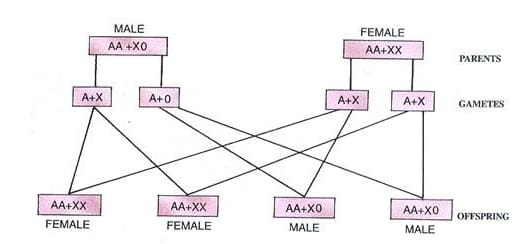
ZW – ZZ type
Example – Birds
Here, females are heterogametic as they produce two types of egg Z and W while males are homogametic which produce only Z type of sperms.
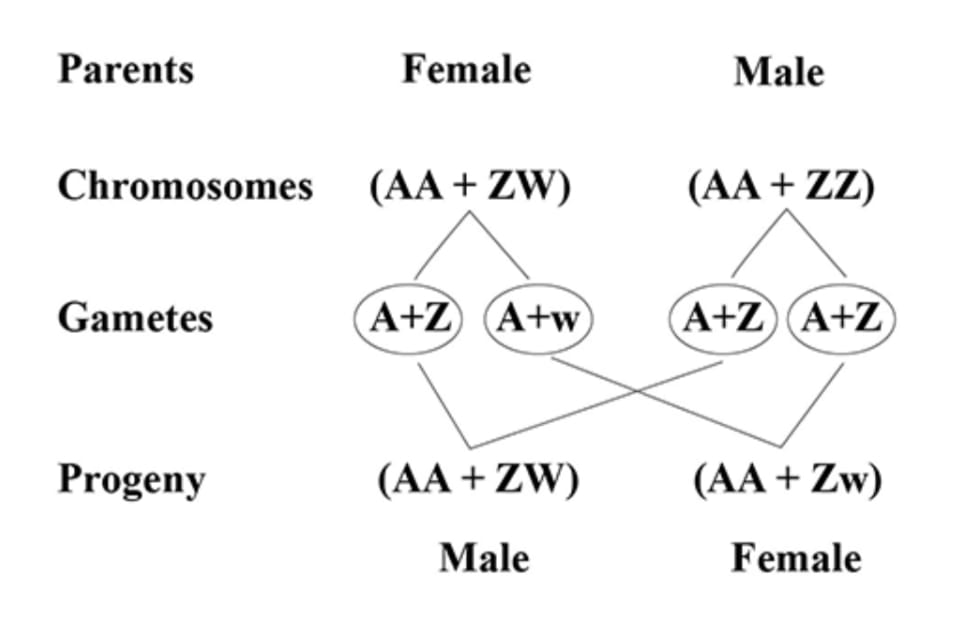
ZO – ZZ type
Example – Butterfly
Here, females only have one Z – Chromosome while males have two ZZ – Chromosomes.

Mutation
The process of change of genetic information or sudden change in genetic information is known as Mutation.
Many chemical and physical factors are there that induce mutations. Any agent that cause mutation are known as mutagen.
Like UV radiations can cause mutations in organism – it is a mutagen.
Mendelian disorders
Most common Mendelian disorders are Hemophilia, Cystic fibrosis, Sickle – cell anemia, Colour blindness, Phenylketonuria, Thalassemia.
Hemophilia
It is a sex – linked recessive disease.
In this disease, a single protein that is a part of the cascade of proteins involved in the clotting of blood is affected.
It shows its transmission from unaffected carrier female to some of the male progeny. The heterozygous female (Carrier) for haemophilia may transmit the disease to sons. The possibility of a female becoming a haemophilic is extremely rare because mother of such a female has to be at least carrier and father should be haemophilic.
In affected individuals, a simple cut will result in non – stop bleeding.
Sickle – cell anaemia
It is an autosome linked recessive disease and is a qualitative disorder.
This defect is caused by the substitution of Glutamic acid (Glu) by Valine (Val) at the sixth position of the beta globin chain of the hemoglobin molecule due to substitution of codon GAG to GUG.
It can be transmitted from parents to offspring when both the partners are carrier for the gene.
Under low oxygen tension the shape of the RBC changes to elongated sickle like structure from usual biconcave disc due to polymerization of hemoglobin, resulting in decreased oxygen carrying capacity of blood.
Colour Blindness
It is a recessive sex linked disease. Its gene is located on the X – chromosome.
In this disease, individual has normal vision but not able to see a particular colour. It occurs due to the defect in the cone cell.
The colour blind person cannot distinguish between red and green colours.
The probability of male is more to be having colour blind than female.
Thalassemia
It is a quantitive disorder and in this disease, amount of hemoglobin decreases.
There are three types of Thalassemia that are alpha, beta and delta.
In this disease, ability of a body get affected to produce hemoglobin and red blood cells which passes from parents to children through genes.
This leads to anemia and patients also require blood transfusions every two to three weeks to survive.
Chromosomal disorders
Chromosomal disorders are caused due to absence or excess or abnormal arrangement of one or more chromosomes.
Aneuploidy – During the aneuploidy, there is the change in the chromosomal number either one or two chromosome number get increase or decrease.
It occur due to the failure of law of segregation during the gamete formation or due to the non – disjunction of homologous chromosome.
Polyploidy – Absence or failure of cytokinesis after the karyokinesis.
It is quite useful in the plant as it increase the vigour production.
The total number of chromosomes in a normal human cell is 46. In this, 22 pairs are autosomes and one pair of chromosomes are sex chromosomes.
Sometimes, an additional copy of a chromosome may be added in an individual or may lack one of any one pair of chromosomes.
These conditions are known as trisomy or monosomy of a chromosome.
Down’s syndrome
It occurs due to trisomy of 21st number chromosome.
It’s condition is 45 + XX or 45 + XY.
Symptoms of down’s syndrome
- Flat skull
- Have small size palm and finger
- Have prominent palm crease
- Open mouth with furrows tongue
- Small size neck or neck is absent
- Small height with moon shape face
Klinefelter’s syndrome
It is caused due to the presence of an additional copy of X – chromosome resulting into a karyotype of 44 + XXY.
Symptoms of Klinefelter’s syndrome
- Male with female character
- Undeveloped testis and no gamete formation
Turner’s syndrome
It is caused due to the absence of one of the X chromosome (monosomy of X chromosome) i.e. 44 + XO.
Symptoms
- Female with undeveloped female character
- Ovary remain undeveloped and no gamete formation.
- Mammary gland do not develop
- Mensuration cycle absent
- Female is sterile
# Principles of Inheritance and Variation
# Principles of Inheritance and Variation Class 12
# Principles of Inheritance and Variation Notes
# Principles of Inheritance and Variation NCERT Solutions
Do share the post if you liked Principles of Inheritance and Variation. For more updates, keep logging onBrainyLads

